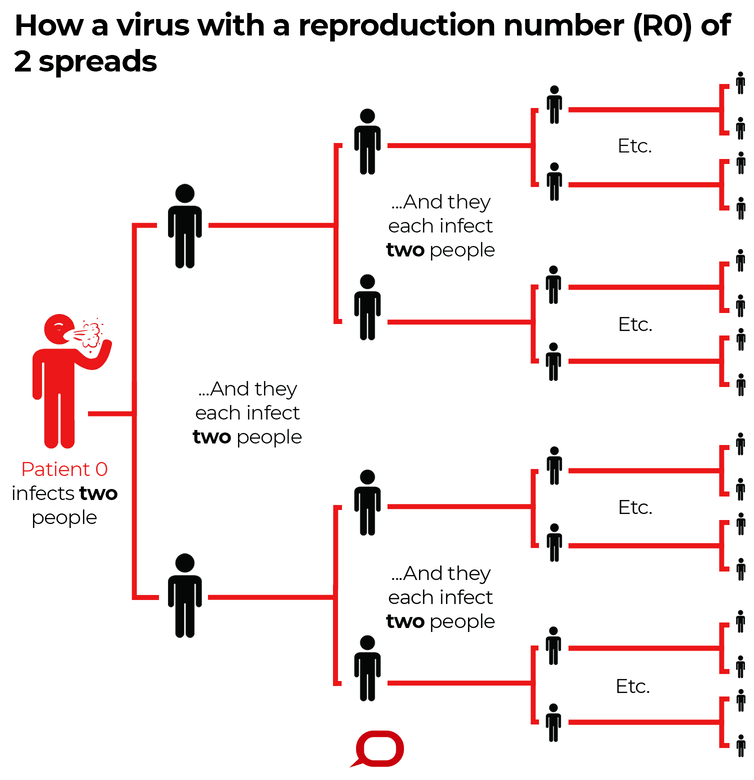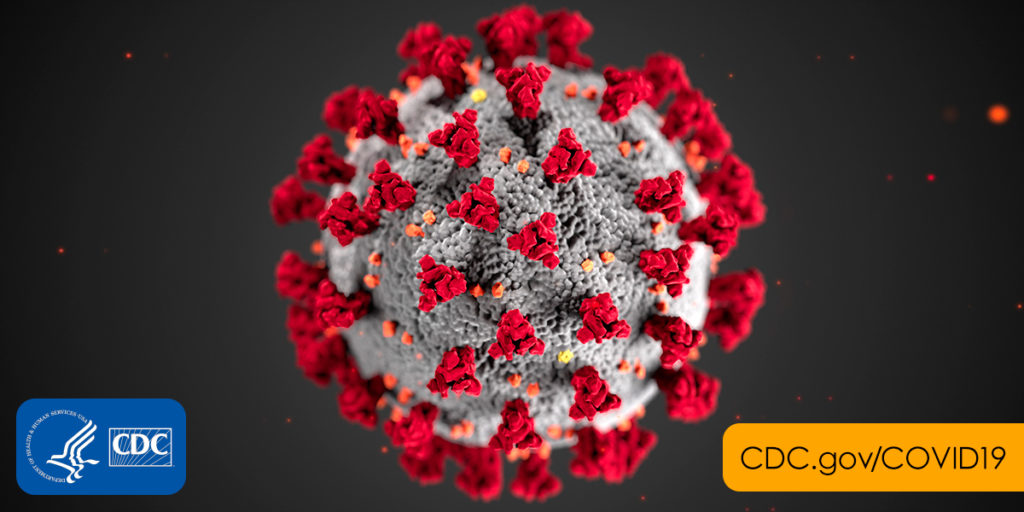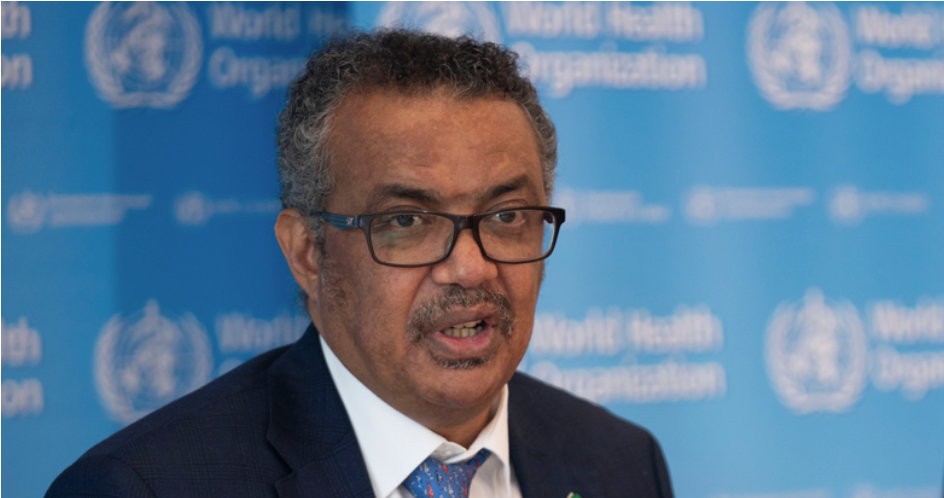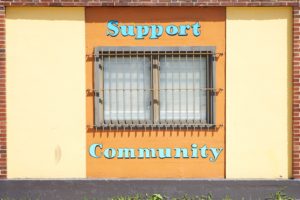As graduate students in health, the editors of Intervene Upstream find ourselves in the unprecedented situation of learning about the science of public health while a pandemic unfolds in front of our eyes. Given the unprecedented spread of both the COVID-19 virus and information (and misinformation) about the virus, we present to you what we hope will serve as a foundation for all of us to better understand the public health approach to COVID-19, using the ubiquitous mechanics of the ABCs.
A: An acquaintance network refers to the connections, relationships, and dynamics of a group of people who are in regular contact with each other who transmit information, infectious agents and behavior among the group. In the case of COVID-19, we can stem the spread of an infectious agent by limiting physical contact with our acquaintance network while transmitting information about personal hygiene and social distancing.
B: The basic reproductive rate (R0) measures the number of infections produced by an infected individual in the early stages of an epidemic when a large proportion of their acquaintance network are still susceptible to disease. This depends on three things: the probability of transmission per contact, the average number of susceptibles in infectious contact and the average duration of infectiousness. Absent extreme measures to quarantine individuals, it is estimated that the coronavirus’ basic reproductive rate is 2.5, which means each infected person will transmit the disease to 2-3 people.12

C: Coronaviruses are a family of viruses that cause a range of illnesses including the common cold, Middle East Respiratory Syndrome (MERS-CoV) and Severe Acute Respiratory Syndrome (SARS-CoV). These viruses can cause respiratory symptoms, fever, cough, shortness of breath and breathing difficulties that can, in severe cases, lead to pneumonia, severe acute respiratory syndrome, kidney failure, and death. COVID-19 symptoms include fever, cough and/or shortness of breath 2-14 days after exposure.3. If you might be sick, follow these instructions: https://www.cdc.gov/coronavirus/2019-ncov/if-you-are-sick/steps-when-sick.html

D: Social distancing reduces the amount of physical contact within an acquaintance network and in community life. Distancing requires not going to places where large crowds gather – such as concerts, libraries, places of worship, sporting arenas, etc. This is a proven way to slow pandemics; it was used successfully during the Spanish flu in the 1920s.4
E: An emerging infectious disease is one that has been recently identified and classified and has the potential to cause epidemics. HIV, ebola virus disease, Legionnaires’ disease and Lyme disease were all once considered emerging infections. These are distinct from reemerging infections, which are old diseases that have experienced a resurgence, such as tuberculosis and syphilis. While there is not a clear definition for how long a disease must subside before being considered remerging, an emerging disease is often more clear. COVID-19 is an emerging infectious disease because this is the first time we have seen the infection in humans.
F: Along with social distancing, flattening the curve has become a quintessential rallying cry for controlling COVID-19. The curve refers to the number of cases occurring over a given period of time since the first case. As the number of cases rises, there are fewer people at risk (once you become infected, you are no longer considered “at-risk”), so the peak in cases is followed by a decline. The healthcare system, however, can only handle a finite number of people at once (because of a limited number of ventilators, masks, other equipment, and healthcare workers themselves). Flattening the curve implies that we need to decrease the peak and spread out the number of cases over time to ensure that healthcare systems do not get overburdened.5

G: Globalization is a process whereby local, regional, and national economic, financial, cultural, medical and political resources are intertwined on a global scale. COVID-19 has spread across borders, and the supply of goods can be limited due to worldwide demand and disruptions in the supply chain that links factories and enables the production and distribution of products utilizing parts, technologies, and raw materials from around the world. The fast spread of COVID-19 occurred because of easily accessible travel across the planet. In turn, reducing the spread of COVID-19 may require closing borders.6
H: A host is a person or living thing that infectious agents become attached to. A COVID-19 host may be asymptomatic (i.e,. not showing symptoms) or appear to be sick sometime after infection. Since anyone can become a host without demonstrating symptoms, it is important to practice good hygiene by washing your hands, not touching your face, using sanitizer and coughing into the crook of your elbow. To protect yourself, follow these instructions.7
I: Incidence is a measure of the probability of occurrence of a given medical condition in a population over a given period of time. Incidence is calculated as the number of new cases during a specified time interval over the population at the start of the time interval. Coming up with the numerator requires testing for the virus. During this pandemic, we commonly refer to the number of cases after a certain number of days since the 100th confirmed case. In this way, we can compare incidences from different countries.
J: Justice may seem, at first glance, unrelated to public health; however, many schools of public health uphold social justice and science as paramount virtues. Justice refers to the morally defensible distribution of resources in society. In terms of COVID-19, justice can be invoked to provide ample protections for people who are houseless, imprisoned, at risk for infection, essential employees, unemployed and low-income earners.
K: Knowledge integration refers to the process of selecting, storing, analyzing, integrating and disseminating information within and across disciplines. Scientific data must be translated into discoveries and practices that individuals and populations can implement. For instance, epidemiologists understand the importance of social distancing to flatten the curve, but this knowledge needs to be integrated into society through the media, executive actions, and collective behavior.
L: Latency period, also called the incubation period, is the time interval between invasion by an infectious agent and the appearance of the first sign or symptom. Recent research shows that the median latency period of COVID-19 is between 4.5 and 5.8 days, and that 97.5% of people who develop symptoms do so between 8.2 and 15.6 days after exposure. ((Lauer SA, Grantz KH, Bi Q, et al. The Incubation Period of Coronavirus Disease 2019 (COVID-19) From Publicly Reported Confirmed Cases: Estimation and Application. Ann Intern Med. 2020; [Epub ahead of print 10 March 2020]. doi: https://doi.org/10.7326/M20-0504))
M: Morbidity rate is the frequency or proportion with which a disease appears in a population. This rate is used by actuarial professionals to determine the premiums charged to customers for life insurance, health insurance, and long-term care.
N: A needs assessment determines the nature and extent of problems experienced by a certain population. A needs assessment can provide information about unmet health needs and can be used to make recommendations to address those health needs. These needs can be medical, psychological or social in nature. With COVID-19, we can estimate the number of infected people to understand the need for additional ventilators and ICU hospital beds8, and the need for sustained income as economic activity slows due to social distancing.9
O: Outbreak is a sudden increase in occurrences of a certain disease during a specific time period and place. The COVID-19 outbreak originated in Wuhan, Hubei, China in December 2019. While we often think about outbreaks on the level of epidemics, an outbreak can also mean a bump of a small number of linked cases of a rare disease.
P: A pandemic is a near-global disease outbreak declared when people in multiple areas across the world experience infections. On March 11th, the World Health Organization declared COVID-19 pandemic, but one that could be controlled as long as countries were able and willing to take up preventive measures such as screening, quarantining and social distancing.10

Q: Quarantine is the isolation of people who either have a contagious disease or have been exposed to one, in an attempt to prevent the spread of the disease. People who have been exposed to COVID-19 are generally recommended to self-quarantine for at least 14 days.
R: A risk factor is anything that increases the chance for an individual or a group of people to be sick, injured or die. Being immunocompromised and above the age of 59 are two risk factors for suffering more severe cases of COVID-19.
S: Screening is the use of simple tests across an apparently healthy population to identify individuals who have risk factors or early stages of the disease, but do not yet have symptoms. Generally, the more sensitive a screening test is – the better able it is to correctly identify people with the disease – the more useful it is. This factors in cost, ease, and efficiency of the test, along with other factors. While testing remains important, many experts argue that the decisive moment for aggressive testing has passed in the United States. South Korea aggressively tested and quarantined individuals early in the epidemic, preventing the spread of cases throughout the population and accompanying overload of health systems. There isn’t a national or international centralized database for COVID-19 testing, so it is difficult to know the true number of people being tested. We can see the most recent estimates below:
Stigma leads to shunning, isolation and discrimination in public life. In 2015, the World Health Organization recognized that disease names of the past have led to increased stigma and discrimination towards different people and economic industries. As such, they recommend against naming new human infectious diseases after geographic locations or industries. COVID-19 follows the best practices for naming conventions; despite this, many people relate the virus to the geographic area where it was first identified, leading to discrimination against Chinese Americans.11
T: Triage is the practice of selecting for care/treatment the individuals who are the highest priority or, in resource-limited settings, who are more likely to benefit from care. COVID-19 cases are increasing, while many areas are suffering shortages of clinicians and equipment needed to provide care. Triage will need to be performed to determine which patients should receive respirators, for example, a practice that is now commonplace in Italy. Guidelines are emerging to determine who receives care.12 Furthermore, individuals will need to self-triage – determine if the symptoms they are experiencing warrant venturing out to receive care.13
You can check your risk for COVID-19 here: https://c19check.com/start
U: Underreporting often applies to health events that are not fully captured by the surveillance system in place. There are a multitude of reasons why underreporting is common, including stigma and lack of access to care. Several states are reporting only positive COVID-19 test results, which may misrepresent how fast the virus spreads14
V: A virus is a microscopic infectious agent composed of DNA or RNA surrounded by protein. Since viruses require a living cell to replicate, they are not classified by biologists as living. COVID-19 is a virus. Vaccination refers to immunization against an infectious agent. A vaccine is a substance used to activate immunization by introducing a live modified or attenuated, or inactivated infectious organism or toxin. The body’s immune system becomes stimulated, resulting in resistance to infection. According to the WHO, as of March 20th, there are two candidate vaccines in phase 1 clinical evaluation and 42 candidate vaccines in preclinical stages.15
W: Whistle-blowers play a fundamental role in public health because they inform authorities, the media or communities when fraud or misrepresentation in research or scientific fact has occurred. Dr. Li Wenliang, an ophthalmologist working in Wuhan, China, where the epidemic originated, attempted to warn medical professionals in late December about cases that were similar to SARS. Within days, Dr.Wenliang was reprimanded by local police and, a few days later, signed a statement saying he was making “false statements.” Dr. Wenliang was later hospitalized with coronavirus and died. The top anti-corruption body in China stated it would investigate these issues.16

Z: A zoonotic agent can be transmitted between animals and people. SARS-CoV was transmitted by civet cats to humans and MERS-CoV from dromedary camels to humans. There are many coronaviruses common in other animals that have not infected humans. The investigation is still ongoing concerning where COVID-19 originated and how it was transmitted to humans through an intermediate animal host.17
No doubt we are still understanding the nature and impact of the COVID-19 pandemic, which has already altered the course of history. By concurrently learning about epidemiology and the epidemic, we can better appreciate and critique how various officials are responding to scientific evidence. As we try to tackle COVID-19 and associated problems, we must rely on each other for mutual support and community solidarity.
We wish good health and safety to everyone’s friends, families, and loved ones! Let evidence and science be our guide as we remain faithful and resilient in the coming days, weeks and months.
- Series 4– Public Health Solidarity - September 15, 2020
- Inequity, Domination, and Liberation during COVID-19 - September 15, 2020
- Archive – The Palate, Nutrition and Public Health - July 6, 2020
- The Atlantic, “How Fast and Far Will the New Coronoavirus Spread, https://www.theatlantic.com/science/archive/2020/01/how-fast-and-far-will-new-coronavirus-spread/605632/ [↩]
- University of Minnesota Health, “How Scientists Quantify the Intensity of an Outbreak Like COVID-19,” https://labblog.uofmhealth.org/rounds/how-scientists-quantify-intensity-of-an-outbreak-like-covid-19 [↩]
- World Health Organization, “Coronavirus,” https://www.who.int/health-topics/coronavirus [↩]
- New York Times, “Wondering About Social Distancing,” https://www.nytimes.com/2020/03/16/smarter-living/coronavirus-social-distancing.html [↩]
- NPR, “Flattening A Pandemic’s Curve: Why Staying Home Now Can Save Lives,” https://www.npr.org/sections/health-shots/2020/03/13/815502262/flattening-a-pandemics-curve-why-staying-home-now-can-save-lives [↩]
- New York Times, “A Global Outbreak is Fueling the Backlash to Globalization,” https://www.nytimes.com/2020/03/05/business/coronavirus-globalism.html [↩]
- CDC, “How to Protect Yourself COVID-19,” https://www.cdc.gov/coronavirus/2019-ncov/prepare/prevention.html [↩]
- New York Times, “The Calculus of Coronavirus Care,” https://www.nytimes.com/2020/03/20/well/live/coronavirus-covid-doctor-nurse-shortage-staff.html [↩]
- Human Rights Watch, “US: Address Impact of Covid-19 on Poor,” https://www.hrw.org/news/2020/03/19/us-address-impact-covid-19-poor [↩]
- World Health Organization,”WHO Director-General’s opening remarks at the Mission briefing on COVID-19 – 12 March 2020″ https://www.who.int/dg/speeches/detail/who-director-general-s-opening-remarks-at-the-mission-briefing-on-covid-19—12-march-2020 [↩]
- The Guardian, “‘ Coughing while Asian’: living in fear as racism feeds off coronavirus panic” https://www.theguardian.com/world/2020/mar/24/coronavirus-us-asian-americans-racism [↩]
- NPR, “US Hospitals Prepare Guidelines for who gets care amid coronavirus surge” https://www.npr.org/2020/03/21/819645036/u-s-hospitals-prepare-guidelines-for-who-gets-care-amid-coronavirus-surge [↩]
- The Atlantic, “After Cancellation Comes Triage”, https://www.theatlantic.com/ideas/archive/2020/03/after-cancellation-comes-triage/608146/ [↩]
- US News, “Some States Are Reporting Incomplete COVID-19 Results, Blurring The Full Picture.” https://www.usnews.com/news/best-states/articles/2020-03-25/some-states-are-reporting-incomplete-covid-19-results-blurring-the-full-picture [↩]
- World Health Organization, “Novel Coronavirus Landscape” https://www.who.int/blueprint/priority-diseases/key-action/novel-coronavirus-landscape-ncov.pdf?ua=1 [↩]
- Huang, Joyce. “Where Is Investigation Report Into Coronavirus Whistleblower?” VOA News. https://www.voanews.com/science-health/coronavirus-outbreak/where-investigation-report-coronavirus-whistleblower [↩]
- World Health Organization, “Coronavirus” https://www.who.int/health-topics/coronavirus [↩]





Pingback: Intervene Upstream Issue 3 - Underlying: Reflections on Condition » Intervene Upstream, the online peer-reviewed public health publication for graduate students